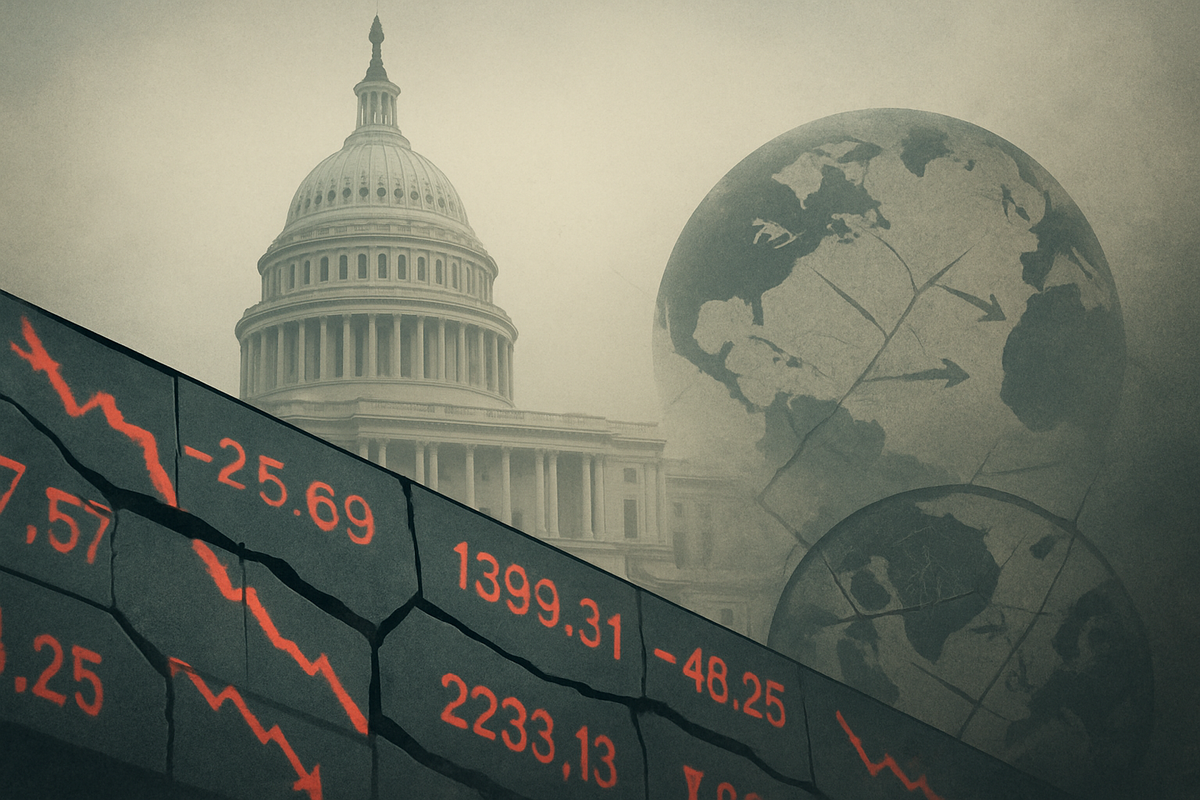
Washington D.C. – October 10, 2025 – The United States federal government finds itself in its tenth day of an active shutdown, a consequence of congressional deadlock over appropriations legislation for the 2026 fiscal year. This fiscal impasse, which commenced on October 1st, 2025, has sent ripples of uncertainty through the financial markets, contributing significantly to a palpable sense of volatility. As federal employees face furloughs and essential services grapple with partial suspensions, investors are navigating a complex landscape where domestic political instability converges with burgeoning international trade disputes.
The immediate implications for the stock market have been evident, with major indices experiencing notable declines on October 10th. While the government shutdown undeniably weighs on investor sentiment, the market's unease is further compounded by President Trump's recent announcement regarding a "massive increase" in tariffs on Chinese imports. This dual threat of internal political dysfunction and external trade friction has created a precarious environment, challenging the resilience of an already sensitive global economy.
Active Shutdown Deepens, Economic Data Delayed
The current government shutdown is rooted in deep partisan disagreements surrounding federal spending levels, proposed foreign aid rescissions, and contentious health insurance subsidies. Despite ongoing negotiations, both the Senate and the House have adjourned without resolving the stalemate, guaranteeing the shutdown's continuation into the following week. This prolonged legislative paralysis has led to the furlough of approximately 900,000 federal employees, with an additional 700,000 continuing to work without pay, creating significant financial strain for hundreds of thousands of American households. The Office of Management and Budget (OMB) Director Russ Vought has confirmed that "reductions-in-force" (layoffs) of government employees have already commenced, signaling a deepening crisis.
While critical services such as Medicare, Medicaid, and the Transportation Security Administration (TSA) remain operational, numerous federal agencies, including the National Institutes of Health (NIH) and the Centers for Disease Control and Prevention (CDC), are facing partial or complete operational suspensions. The Internal Revenue Service (IRS) has also largely shuttered its operations, furloughing nearly half of its workforce after an initial five-day contingency period. A significant consequence for the financial markets is the delay in the release of crucial government economic reports, most notably the September 2025 Consumer Price Index (CPI) report, which is now not expected until the end of the month. This absence of timely economic data further obscures the market's ability to accurately assess the nation's financial health, exacerbating uncertainty.
Initial market reactions on October 10th saw the S&P 500 (NYSE: SPX) decline by 1.8%, the Dow Jones Industrial Average (NYSE: DJI) by 1.2%, and the Nasdaq Composite (NASDAQ: IXIC) by nearly 2%. While these drops reflect the immediate impact of the shutdown, analysts note that the tech sector, in particular, suffered amplified declines following the President's tariff threats, highlighting the multifaceted nature of current market pressures. Historically, while some analyses suggest that market responses to government shutdowns have often been relatively short-lived, with quick rebounds, the current environment, coupled with trade tensions, presents a more complex and potentially damaging scenario for sustained economic stability.
Companies Navigate a Treacherous Landscape: Winners and Losers Emerge
The protracted government shutdown creates a highly uneven playing field for public companies, with some sectors bracing for significant headwinds while others may demonstrate surprising resilience. Companies with deep ties to federal contracts, those reliant on government regulatory functions, and businesses sensitive to consumer confidence are likely to bear the brunt of the fiscal impasse.
Government contractors, particularly in defense and IT services, are among the most vulnerable. Firms like Science Applications International Corporation (SAIC) (NYSE: SAIC), a major provider of technical, engineering, and enterprise information technology services, have historically faced substantial costs during shutdowns, struggling to maintain payroll without federal reimbursement. Larger tech giants with significant government contracts, such as Oracle (ORCL) (NYSE: ORCL) (serving intelligence communities), Microsoft (MSFT) (NASDAQ: MSFT) (providing Office 365 for government), and IBM (IBM) (NYSE: IBM) (via its Red Hat subsidiary), could experience crimped earnings due to delayed government tech spending and stalled contract fulfillment. Small and medium-sized contractors, which often operate on tighter margins, face even more severe cash flow issues, jeopardizing their ability to meet operational expenses.
Beyond direct contractors, companies dependent on federal regulatory approvals and services are also at high risk. The biotechnology and pharmaceutical sectors, for instance, heavily rely on the Food and Drug Administration (FDA) for drug approvals and clinical trial reviews. A prolonged shutdown means significant delays, pushing back product launches and impacting future revenue streams. Similarly, the Securities and Exchange Commission (SEC) operates with minimal staff during a shutdown, effectively halting the review and declaration of effectiveness for Initial Public Offerings (IPOs) and other registration statements, thereby delaying capital raises and market access for numerous companies, especially smaller startups. The airline industry, including carriers like Delta Air Lines (DAL) (NYSE: DAL), could face indirect but significant disruptions from understaffed air traffic control (ATC) services and longer security lines due to unpaid Transportation Security Administration (TSA) workers, alongside reduced business travel from furloughed federal employees. The real estate and lending sectors also suffer as agencies like the Federal Housing Administration (FHA) and Small Business Administration (SBA) slow down loan processing.
Conversely, certain sectors and companies are better positioned to weather the storm, or may even be perceived as "safe havens" by investors. Defensive sectors, which provide essential goods and services, tend to maintain stable demand regardless of political or economic uncertainty. Utility companies, for example, typically see consistent demand as their services are indispensable. The healthcare sector, with major players like UnitedHealth Group (UNH) (NYSE: UNH), often exhibits resilience due to the non-discretionary nature of medical services and long-term demographic trends like an aging population. Consumer staples companies, such as Procter & Gamble (PG) (NYSE: PG) (maker of household essentials like Tide and Crest) and Walmart (WMT) (NYSE: WMT), are also likely to experience predictable demand. In times of economic uncertainty, consumers may even shift towards value retailers or engage in "pantry-loading," which can bolster sales for these companies. Additionally, select technology companies with robust balance sheets and durable earnings capacity, like Nvidia (NVDA) (NASDAQ: NVDA), might be favored by investors seeking quality growth stocks amidst the turmoil.
Broader Implications and Historical Echoes
The ongoing US government shutdown, exacerbated by the current political climate and global trade tensions, extends its reach far beyond the immediate operational disruptions, carrying significant wider implications for the economy and financial markets. This event is not merely a temporary inconvenience but a symptom of deeper political polarization that can undermine economic stability and investor confidence over the long term. Each week of a prolonged shutdown is estimated to shave off 0.1% to 0.15% from annualized GDP growth, creating a drag on the overall economy.
One significant ripple effect is the erosion of confidence in government functionality, which can deter foreign investment and impact the perception of US economic reliability. The delay in critical economic data releases, such as the September 2025 CPI report, creates an information vacuum that makes it harder for the Federal Reserve and other policymakers to make informed decisions, potentially leading to policy missteps. Furthermore, the financial strain on furloughed federal employees and contractors can lead to a decrease in consumer spending, particularly in regions with high concentrations of federal workers, impacting local economies and subsequently national retail and hospitality sectors. The current situation fits into a broader trend of increasing political brinkmanship in fiscal matters, a pattern that has become more frequent over the past two decades.
Regulatory and policy implications are also profound. Projects requiring federal permits, from environmental assessments for energy infrastructure to new product approvals in various industries, face indefinite delays. This bureaucratic paralysis can stifle innovation and economic expansion. For instance, the EPA's reduced operations can halt the progress of vital energy projects, while the Bureau of Industry and Security (BIS) and the Directorate of Defense Trade Controls (DDTC) delays in processing export licenses can disrupt international trade for companies involved in sensitive goods and technologies. Historically, while short shutdowns have often seen markets rebound quickly, the current environment, coupled with President Trump's tariff threats, presents a more complex picture. Past shutdowns, such as those in 2013 and 2018-2019, generally resulted in temporary market dips followed by recoveries once the government reopened. However, the current confluence of an active shutdown, significant layoffs, and escalating trade wars could lead to a more sustained period of market fragility and economic slowdown.
What Comes Next: Navigating Uncertainty
The path forward for the US economy and financial markets, amidst an active government shutdown and escalating trade tensions, is fraught with uncertainty, presenting both short-term challenges and long-term strategic considerations. In the immediate future, the primary focus remains on the duration of the shutdown. A swift resolution could lead to a quick market rebound, aligning with historical patterns of short-lived government shutdown impacts. However, given the deep partisan divides, a prolonged shutdown is a distinct possibility, which would amplify economic damage and market volatility.
In the short term, companies will need to activate contingency plans to manage cash flow, retain critical staff, and navigate regulatory delays. Government contractors, in particular, may need to seek alternative financing or scale back operations to conserve capital. Investors, meanwhile, will continue to monitor legislative developments closely, watching for any signs of compromise or escalation. The delay in economic data will make it challenging to gauge the true health of the economy, potentially leading to overreactions to limited information. A critical point will be the impact on consumer sentiment and spending, especially as federal workers continue to miss paychecks.
Looking further ahead, the event underscores the need for businesses to build resilience against political and economic shocks. Diversification of revenue streams, reduced reliance on single government contracts, and robust financial planning will be paramount. For the market, opportunities may emerge in defensive sectors and safe-haven assets. Companies in essential services, consumer staples, and those with strong international diversification might prove more resilient. Conversely, firms heavily exposed to domestic government spending or regulatory processes will need to consider strategic pivots. Potential scenarios range from a quick, negotiated end to the shutdown, leading to a modest recovery, to a protracted stalemate that could trigger a more significant economic downturn, potentially pushing the Federal Reserve to reconsider its monetary policy stance. The interaction between the shutdown's economic impact and the trade war's effects will be crucial in shaping the trajectory of the market.
A Precarious Balance: Market Outlook and Investor Vigilance
The ongoing US government shutdown, now in its tenth day and compounded by rising trade tensions, casts a long shadow over the financial markets, highlighting the fragility of investor confidence in the face of political instability. The key takeaway from this event is the profound impact that domestic political gridlock can have on economic activity and market sentiment, especially when intertwined with other significant macroeconomic pressures. The furlough of hundreds of thousands of federal employees, the delay of crucial economic data, and the operational paralysis across numerous government agencies are not merely bureaucratic hiccups; they represent tangible headwinds to growth and stability.
Moving forward, the market's trajectory will largely depend on the duration and eventual resolution of the shutdown, as well as the evolving landscape of US-China trade relations. While historical precedents suggest that markets often recover relatively quickly from short shutdowns, the current environment is unique due to the confluence of multiple, severe uncertainties. Investors should brace for continued volatility and be prepared for potential shifts in market leadership as capital flows towards more resilient sectors. The resilience of consumer spending, particularly in regions heavily populated by federal employees, will be a critical indicator to watch, as any significant dip could exacerbate economic slowdown fears.
In the coming months, investors should remain highly vigilant, focusing on companies with strong balance sheets, diversified revenue streams, and those operating in sectors less directly impacted by government operations or discretionary consumer spending. Monitoring legislative progress in Washington, keeping an eye on the release of delayed economic indicators, and assessing the true economic impact of the dual challenges of a shutdown and trade war will be paramount. This period serves as a stark reminder that political stability is a fundamental pillar of economic prosperity, and its disruption can have far-reaching and lasting consequences for public companies and the broader financial landscape.
This content is intended for informational purposes only and is not financial advice






